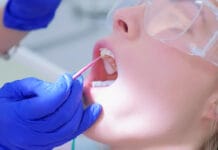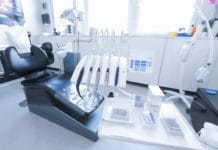Dr. Emily Boge, EdD, RDH, CDA, FAADH, FADHA
She is an Iowa native who is a key opinion leader, speaker, innovator, and director of not only a dental hygiene program but a dental assisting program. Dr. Emily Boge, EdD, RDH, CDA, FAADH, FADHA, is extremely involved in our profession in many different avenues.
In this interview, you will learn about Emily’s background and how she got to where she is today.
Machado: What made you decide to become a dental hygienist? What is your why?
Boge: I was in pharmacy school and decided it was not my jam. I took a career inventory survey, and everything pointed to the dental profession. Preventive dental care sounded much more appealing to me than restorative, so I decided to start the dental hygiene journey. I completed the accredited program at Hawkeye Community College for Dental Assisting, then got into the Dental Hygiene program as soon as I completed my prerequisites.
My why, at this point in my career journey, is other dental hygienists. I want to make this career the best it can be for students, new graduates, and fellow licensed colleagues. Sometimes I accomplish this why through product invention and innovation, other times, it is through leadership at Hawkeye Community College. Yes, the same college where I went to dental assisting and dental hygiene school. Or, I accomplish this by presenting new research to a group of licensees online from the farm in eastern Iowa where I live or a location I am sent somewhere on the globe.
Machado: Can you describe your dental background? How many years have you been a dental hygienist? Educator? Director? Key opinion leader? Speaker?
Boge: My career started as a dental assistant in Iowa in 2000. I worked for the dental programs at Hawkeye Community College as a student employee while taking my dental hygiene prerequisites and while in the dental hygiene program.
I graduated in 2003, then practiced in a rural private practice in Manchester, Iowa, which has a population of 5,000. This practice is in a small town, yet their technology is phenomenal, and the facility is one of the highest quality I have experienced as a dental professional. My 12 years of employment at this practice fostered a respect for lifelong learning and a sincere appreciation for team dentistry. I received only encouragement each time I sought to learn something new or take on a new role in dental hygiene.
Sometimes dental hygienists think that taking on a new role means you leave the operatory or leave the clinical world behind. This is not how I see it. I will always have a piece of my heart that is only filled by clinical dental hygiene.
My first active role in our professional association was in 2004, soon after licensure. I started giving licensee continuing education lectures as a speaker in 2008 and began to serve in some roles on corporate advisory boards in 2009.
People were calling me a key opinion leader (KOL) at this point, but I was not sure what that meant. I was simply a clinical dental hygienist who felt heard by companies, and it fostered such a feeling of respect as a young professional. The more I traveled to help companies, the more I wanted to come back and do it again. At this same time, I went through a period of serious imposter syndrome – claiming that I was not a leader of any sort. The truth was that I was called to leadership but did not fully understand it at this point.
I got my bachelor’s degree in 2012, and when compared to my AAS in dental hygiene degree, I must say it was far simpler! Therefore, when one of my professors told me I needed a master’s, I thought, why not? I graduated with my master’s in public administration in 2015.
As the ink was drying on my master’s, someone from Hawkeye called me and asked what I thought of coming back to the school as the program director for dental assisting and dental hygiene. There were some challenges taking place that they thought I was best qualified to address. At Hawkeye, this position is called the dental administrative chair. This is a 12-month administrative position, where people usually spend years as a college instructor before pursuing. Again, I did not think I was qualified, yet, I thought, why not? So, I interviewed, and they hired me. And you know what? I can do hard things. And I am a leader!
As a clinical dental hygienist at heart, I have the best jobs in the entire world when I am away from my home. I have been the dental administrative chair at Hawkeye for the last eight years, and I really enjoy it. It is not easy, but it is rewarding. In addition, the college is very gracious, allowing me to continue my work as a KOL in the dental industry as a “side job,” my husband has allowed me to remain his wife and co-farmer for the last 20 years, and my kids, their mom.
Machado: Can you explain what a KOL is? What are your favorite topics you speak and educate on?
Boge: KOL means key opinion leader. This is someone who has built a reputation of excellence in the industry that a company trusts to help guide them in innovation, marketing, professional relations and development, education, or a variety of other facets. My favorite topics to speak on are ethics, radiology, risk management, teaching methodology, infection control, and dental sciences. Not Perio.
Machado: What are your favorite things about the dental hygiene profession or being a dental hygienist?
Boge: My favorite thing about being a dental hygienist is helping people. Whether it is chairside in clinic or in my office with a student, it is my passion to serve others. When I left private practice, the students filled the void left by not seeing patients daily.
Machado: You mention you live in rural Iowa. What are some of the common dental concerns and challenges people face based on this specific geography?
Boge: Iowa is a fantastic place. I live in a rural town, yet I travel about an hour west to a larger city each day to work at the college. Iowans face many of the same challenges as in other areas of the country with fewer people, more kindness, and cleaner air – but I might be a bit partial. Iowans face the challenges of finding affordable healthcare and third-party payment systems – much like other areas of the country. Iowans also face the problem of not having enough providers who stay in rural areas to treat this demographic.
Machado: When you were working clinically, what were your responsibilities overseeing a large hygiene team? How did you get this role? What were some challenges you faced in this role? Do you have any advice for other hygienists who are in clinical leadership roles?
Boge: My role in clinical practice changed over time. For the first several years, we did not really have an assigned leader on the hygiene team of seven. Over time, we started a practice management plan that assigned me the task of representing the hygiene team. I did not really have clearly specified tasks other than attending meetings and listening, giving my opinion, and submitting some spreadsheets of production information.
Yet, one of the challenges was I did not have the authority to discuss or act when I saw gaps in our processes. There was no clear definition of the role, and I had no way of establishing procedures. Like in many offices, the duties of the position, or even a title for the position, were not clearly defined on paper.
This was over 10 years ago, and this is an area where dentistry is seeing greater definition as larger dental offices are becoming more common, and this role is becoming more defined. My advice for someone who is in this position is to be sure that there is a job description created if you are put into this role. Daily tasks are much easier at work when roles, policies, and procedures are clearly defined.
Machado: Can you speak on your history working as an educator leading up to being the director of both dental assisting and dental hygiene programs? What does a normal day as two different dental program directors look like for you?
Boge: My role as chair is fun because there really is not a normal day. Sometimes I am in administrative meetings in four different buildings. On other days, I am sitting in my office on Zoom for four hours before teaching histology and embryology in the afternoon. Some days I am subbing in the clinic for dental assisting chairside in the morning, then sitting with a first-year dental hygiene student who got vertigo from her new loupes and just needs someone to hold her hair back as she gets sick, then going to a 7th-grade career fair in the afternoon.
I can take off on a Friday, fly to Buffalo to lecture to a group of hygienists that evening, and be back for Sunday night supper with my mother and family. Yes, my mother still makes supper every Sunday night for whoever can make it. When you birth 11 kids and raise them on a farm, this event is something she cannot un-program from her 80-year-old personality – not like anyone could change her mind if they tried. Many dental hygienists have made guest appearances at Sunday night supper.
Author’s note: Many dental professionals, especially dental hygienists, have either heard of or used the Boge 513. During this portion of the interview, Emily explains how she collaborated with instrument companies, the process, and her influence in designing a new instrument in the dental industry.
Machado: How did creating instruments all come about for you?
Boge: In June of 2014, I was invited to visit Missoula, Montana. American Eagle Instruments was hosting an event for dental hygienist key opinion leaders, and I was chosen. As a clinician at a rural dental practice in Manchester, Iowa, I had just finished my bachelor’s degree and rolled right into a master’s program at Upper Iowa University. I had limited experience outside clinical dentistry, yet I was curious about some instrumentation technology I had seen at the Chicago Midwinter Dental Meeting the previous February.
At that Chicago meeting, I saw the XP Sharpen-Free Technology for the first time. The sales manager I met told me that I would never have to sharpen this type of instrument, and I could not conceive it to be true. How would that even be possible? It went against everything I knew and experienced in school and practice.
Since the innovation was exclusive to American Eagle, I knew I needed to go to Montana if I wanted to satisfy the thousands of questions racing through my brain. At the KOL event, I was educated on the use of the new technology and given some minor technique adjustments to use when I used the instruments in practice chairside. I took these back to Iowa with plans to report back with my experiential perceptions.
I could tell from initially opening and sterilizing the instruments that they were different from other new instruments I had used in my career. I did not need to whittle them down with my sharpening stone, altering the medical device before use, to fit more comfortably into periodontal spaces. I used them, sterilized them, and used them again, and they stayed sharp with unfailing incident.
They were consistently the same device every time I picked them up, and frankly, it annoyed me. Like many dental professionals I know, being wrong is not a feeling I enjoy. When I authored my written report back to American Eagle, I stated that XP instruments turned out to be just as amazing as the product rep had explained. I noticed the difference, not only in the thin yet durable innovation, but my patients also began to comment on the difference. They stated that they were more comfortable during their instrumentation, and it felt like I was using less force inside their mouths.
Over the course of the following months, I replaced all six of my stainless-steel chairside cassettes of instruments with XP Sharpen-Free Technology instruments. When choosing the instruments for my cassettes, I had to also admit how limited my knowledge was when it came to the armamentarium that I did not receive in my own dental hygiene education. If I were wrong about the innovative type of materials used in the manufacturing of XP Sharpen-Free Technology, what else could I be missing from my closed-mindedness? This was one clear turning point in my career when I rid myself of tunnel vision and began to see everything I was missing.
One afternoon I was working on a particularly challenging lingual bar, scaling off tenacious calculus with the hoe scaler given to me by a dentist who was trained in the 1960s. My colleague at the practice and I both loved this scaler yet found it quite difficult to sharpen. I had recently changed my other instruments to XP®, except I kept this stainless-steel hoe.
I contacted American Eagle to ask them if they had an instrument similar to what I used in practice in their XP product line. The product rep said no. I asked, what if you could? What if I brought you a design like a hoe scaler with some modifications to make it easier to use since the clinician will not need to sharpen it? What if we tried a longer terminal shank with a wider cutting edge, then angled the shank more to the shape of the mandible?
Instead of disregarding my suggestions for improvement as others had before, I was referred to as an engineer for potential product development and testing. So, back to Missoula, I went. I met Dennis, the innovation engineer at American Eagle, and he and I worked together for over a year.
I showed him my sketches and explained some of the challenges I saw in practice as a clinician. I explained the anatomy of the arch and the ergonomic challenges in the lower anterior, specifically when patients present with conditions like recession or fixed lingual bars that gather an increased amount of calculus, biofilm, and stain. We sent devices back and forth through the mail to improve the instrument design and function. As we moved through the process, I gained a greater respect for manufacturing and innovation and continued to immerse myself in new instrumentation research and science.
Upon completion of the prototype instrument, I was invited back to Chicago to have dinner with some of the company executives I would be working with to launch the product later that year. At that dinner, a gentleman made a comment to me that I was very tall, to which I responded that yes, I was 5-feet 13-inches, less abrasive than 6-feet 1-inch for a woman. At that moment, the new instrument was named.
We introduced the Boge 513 in Basel, Switzerland, at the International Symposium of Dental Hygiene in June 2016 and then domestically at RDH Under One Roof in National Harbor, Maryland, in July 2016.
Prior to 2017, the sole choice in dental hygiene instrumentation used in clinical entry-level coursework at Hawkeye Community College, was the standard 440A stainless steel. Before this date, the program advisory committee of dental practitioners from across the community college service area supported the use of stainless-steel instrumentation because area private practices primarily used stainless-steel instrumentation only.
As former graduates reported the use of sharpen-free instrumentation in private practice and inquired whether it was possible to introduce several types of instrumentation in the curriculum, a one-year feasibility study was conducted, analyzing the affordability of changing the semester four and five advanced instrumentation kits from stainless steel to sharpen-free technology.
Currently marketed brands were analyzed and evaluated for effectiveness. The study resulted in a decision to diversify instrumentation in the curriculum. Beginning in the fall 2017 academic year, senior dental hygiene students received an advanced instrumentation kit and advanced didactic and clinical instruction on the use and care of American Eagle XP Technology instruments.
Over the course of my 23 years in dentistry, I have seen one constant; if education stops at entry-level program graduation, it is quite easy to become stagnant. Improvement came full circle for me when we embraced structured instrumentation change and introduced variety at the college.
When dental professionals embrace evidence-based innovation and accept the challenge to change, unbelievable discoveries are made. By opening our minds to new techniques, varied fulcrums, and the wide variety of instrumentation choices we can encounter ideas we never thought possible.
Machado: How many instruments and patents do you have? Can you describe the process of creating an instrument or receiving a patent? What is your advice to individuals who want to create an instrument or new product for the dental field?
Boge: I have the Centennial Scaler with Hu-Friedy, the Boge 513 with American Eagle, the Hawkeye Probe with PDT, and two more pending innovations on the burner. My advice is to get non-disclosure agreements (NDAs) signed before sharing your idea and work hard to find a company you trust. Spend the time building relationships and networking before you jump in!
Machado: What would you recommend to someone wanting to work or collaborate with a dental company?
Boge: Same as above. You must feel comfortable and not feel taken advantage of in a situation.
Machado: Because you are so involved throughout the profession, what advice do you have for dental hygienist students? Advice for an experienced hygienist?
Boge: Reach out! Do not become isolated; make friends, network, and enjoy the beautiful humans in our profession that care about each other and the patients we all serve.
Machado: Can you describe what Jell-Ed is and how it came about? What should readers know about this?
Boge: Jell-Ed is a company formed by four dental educators who wanted to increase sharing in the formal educational space. Many educators know how to be dental hygienists but do not know how to be a teacher. Jell-Ed works to help those individuals. It is a safe place to share ideas and learn from other educators.
Machado: What influenced you to go back to school for your doctorate degree?
Boge: If you can complete a dental hygiene CODA-accredited program, you can do anything! Truly. Once I completed my bachelor’s degree, it was natural for me to flow into a master’s, then a doctorate. It was simply a new challenge, and I do love a new challenge.
Machado: Can you describe your doctorate program, such as course load, presentations, and thesis? What was the most challenging aspect of this program? What was the most rewarding aspect of your program?
Boge: My initial doctorate program was in health care education. As I worked to complete this degree plan, I soon realized I wanted to have a greater leadership emphasis, so I switched schools. The result was my successful completion of a doctorate in higher education – organizational leadership from Franklin University in Columbus, Ohio.
The most challenging aspect was settling on my topic for the original research dissertation, and the most rewarding was presenting that topic online to the largest group of attendees the college has ever seen! Dental hygienists show up for each other in support and science! My topic was “Benefits of a Dental Hygienist Obtaining a Baccalaureate Degree: A Qualitative Research Study of Licensees in Five Midwestern States.”
Machado: How are you implementing your doctorate degree in your field and job?
Boge: My leadership and education skills obtained in my doctoral curriculum have given me a richer understanding of why we teach and how we teach in relationship to dental assisting and dental hygiene curricula. I have also taken on a position as an appointed site visitor for the Commission on Dental Accreditation.
Machado: What advice would you give to someone interested in going back to school and continuing their education for any additional degrees, including a doctorate?
Boge: Just keep going. Take off bite-sized pieces and chew them well. One step at a time and take time for self-care. Reach out to your colleagues for support when you need it.
Machado: What are you most proud of from your entire career so far or a memorable moment?
Boge: My most proud moment so far has been my students succeeding and my colleagues attending my lectures off-campus. The trust that people place in my evidence-based information gives me immense pride.
Machado: Is there anything else you would like to share?
Boge: Just kindness. We need to be more kind to each other as dental professionals. We are a team, and every team member has a valuable role.
In Closing
It was such a pleasure finally meeting Emily. I absolutely loved learning about the origin story of the Boge 513 and how it got its name. She wears many hats as a dental hygienist: educator, programs director, key opinion leader, speaker, just to name a few. Emily is such an inspiring, well-rounded dental professional who can definitely put a smile on your face.
Before you leave, check out the Today’s RDH self-study CE courses. All courses are peer-reviewed and non-sponsored to focus solely on high-quality education. Click here now.
Listen to the Today’s RDH Dental Hygiene Podcast Below:
Dr. Emily Boge, EdD, RDH, CDA, FAADH, FADHA












